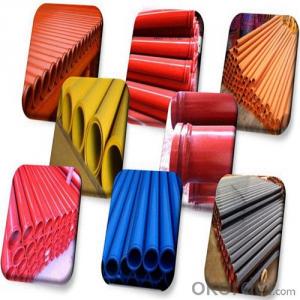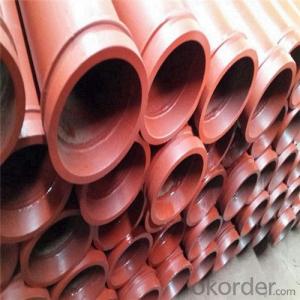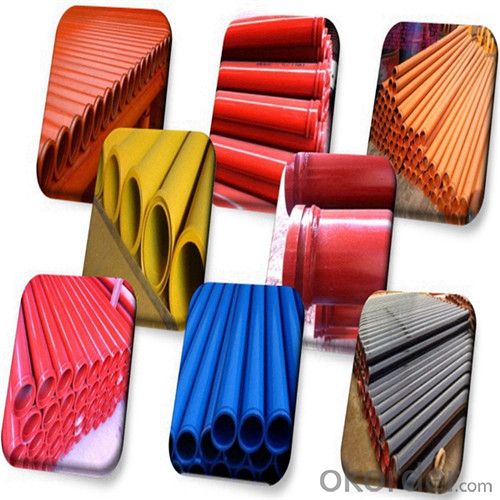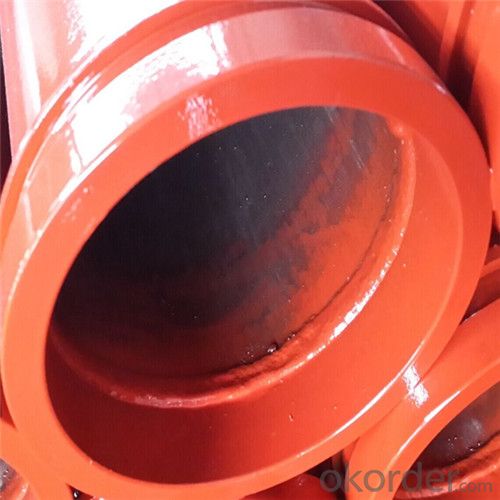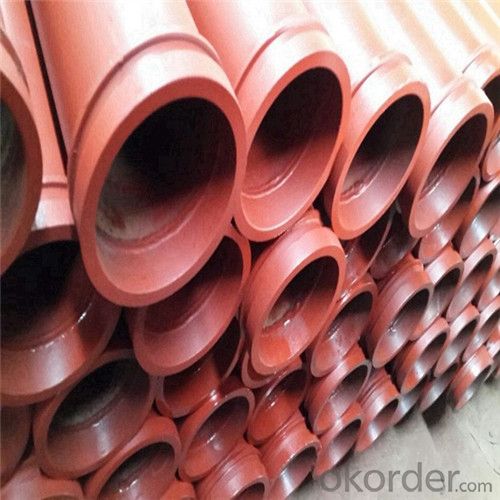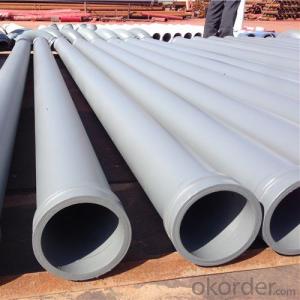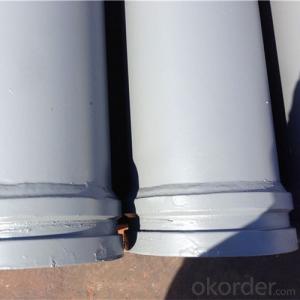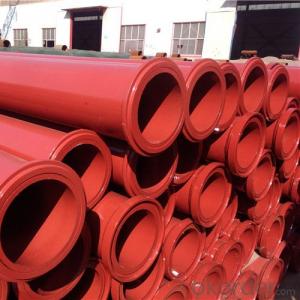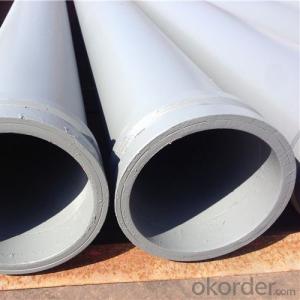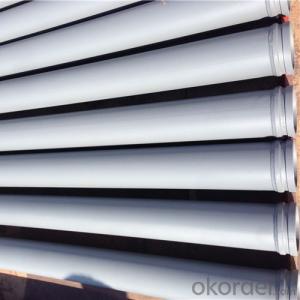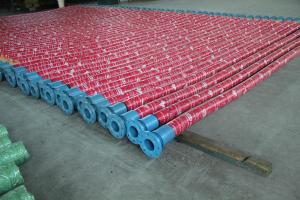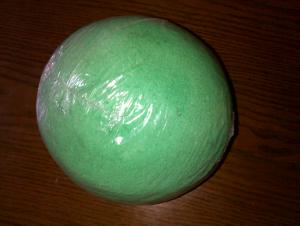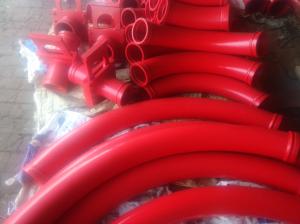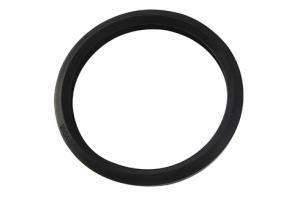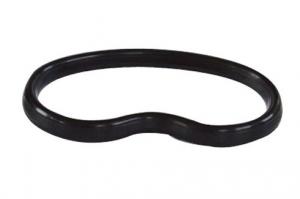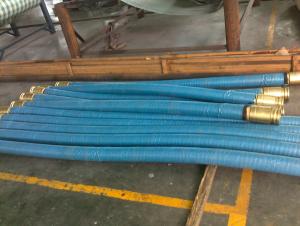3M Seamless Delivery Pipe for Sany Concrete Pump
- Loading Port:
- Tianjin
- Payment Terms:
- TT or LC
- Min Order Qty:
- 50 pc
- Supply Capability:
- 5000 pc/month
OKorder Service Pledge
OKorder Financial Service
You Might Also Like
3M Seamless Delivery Pipe for Sany Concrete Pump
1. Structure of 3M Seamless Delivery Pipe for Sany Concrete Pump:
St52 Seamless Pipe: Now More People like use this kind for Truck Pump and Trailer Pump because of the quality is better and it is seamless kind, so this kind pipe is most popular in Middle East Price About 34USD-37USD.
Wear Resistant Pipe: Use for Truck Pump, Wear Resistant Layer is 2.5mm.Through heat treatment way make this pipe more strong (HRC60-62), Using Life: 25,000m³-35,000m³ Price about 65USD-68USD.
Two Wall Pipe: This pipe thickness (2mm+2.5mm), Using Life about 50,000m³-60,000m³
2. Main Features of 3M Seamless Delivery Pipe for Sany Concrete Pump:
• High Wear-resistant, long service life, lower cost
• In case of quality problem the company provide free replacement.
• Provide technical support for free.
• Provide consumers with regular visits
• Ensure the supply of ancillary parts
• Our company passed the ISO9000 certification, the product through 3C certification in full compliance with national standards
3. 3M Seamless Delivery Pipe for Sany Concrete Pump Images
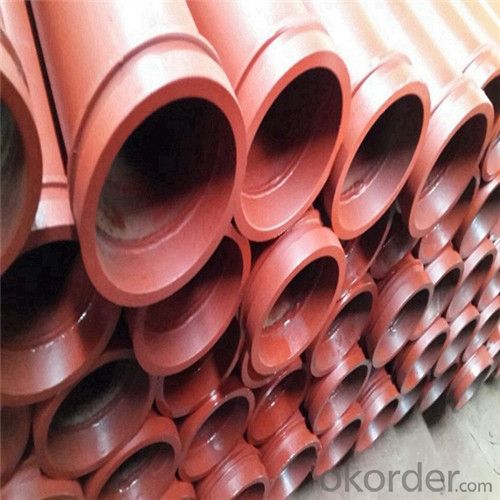
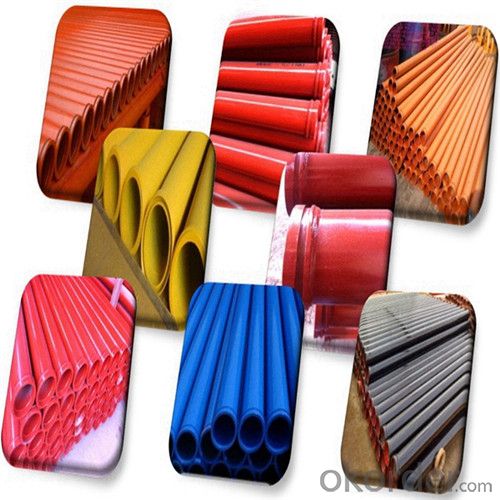
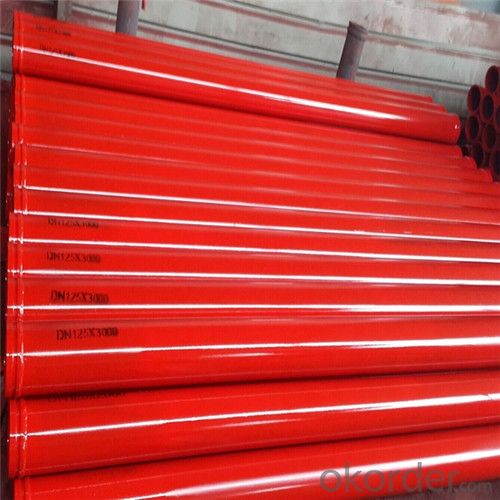
4. 3M Seamless Delivery Pipe for Sany Concrete Pump Specification
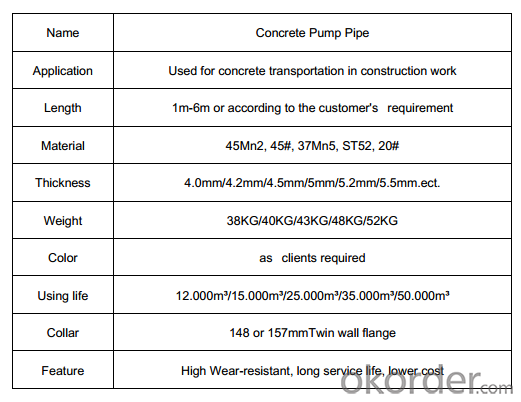
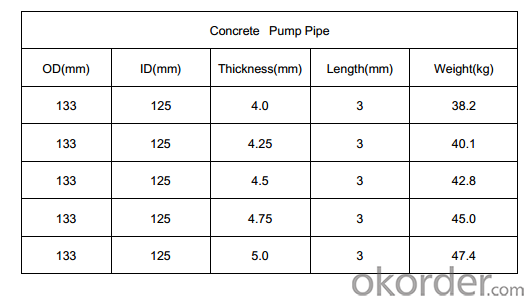
Production Process
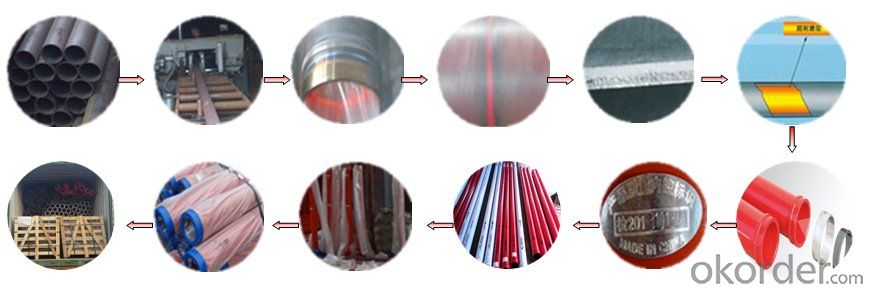
5. FAQ
We have organized several common questions for our clients, may help you sincerely:
①Is your products exported a lot?
We have exported to many, many countries. Every year we ship more than 30 containers of these spare parts. Our main market is in Middle-east, Asia & Africa.
②How to guarantee the quality of the products?
We have established the international advanced quality management system,every link from raw material to final product we have strict quality test;We resolutely put an end to unqualified products flowing into the market. At the same time, we will provide necessary follow-up service assurance.
③How long can we receive the product after purchase?
In the purchase of product within three working days, we will arrange the factory delivery as soon as possible. The specific time of receiving is related to the state and position of customers. Commonly 15 working days can be served.
6. Why choose us
• We are a comprehensive manufacturing and trading company.
• We have been specialized in producing concrete pump spare parts and specialized in producing all kinds of concrete pump parts. As Concrete Pump Pipe, Concrete Pump Elbow, Concrete Pump Rubber Hose, Concrete Pump Wear Plate, Concrete Pump S Valve, Concrete Pump Piston and so on.
• We have been supplying concrete pump parts for SCHWING, PUTZMEISTER, SANY, CIFA, KYOKUTO, ZOOMLION for 10 years, so we can promise you the quality and best price.
- Q: What is the difference between concrete pump and ground pump?
- The pump is actually the day Linuo arm frame of concrete pump boom is known, a few day, after mixing through the boom pump, the efficiency is very high
- Q: How often should I replace concrete pump spare parts?
- The frequency of replacing spare parts for concrete pumps is determined by several factors, including the quality of the parts, how frequently they are used, and regular maintenance. It is generally recommended to regularly inspect and maintain the spare parts to detect any signs of wear or damage. As a precautionary measure, it is advisable to replace parts that display significant wear or are no longer functioning optimally. However, it is essential to adhere to the manufacturer's guidelines and recommendations for the specific model of concrete pump being used. Additionally, seeking advice from experienced professionals or technicians in the field can offer valuable insights into the expected lifespan of different spare parts and when replacements may be required.
- Q: What is the purpose of a concrete pump boom?
- The purpose of a concrete pump boom is to provide an efficient and effective method for transferring concrete from the mixer truck to the desired location on a construction site. The boom is typically mounted on a truck or trailer and consists of a series of connected sections that can be extended and maneuvered to reach areas that are otherwise difficult to access. Concrete pump booms offer several advantages over traditional methods of concrete placement. Firstly, they significantly reduce the labor required for concrete placement, as the boom can reach over obstacles such as buildings or other structures, eliminating the need for manual pouring or the use of cranes. This saves time and money on a construction project. Additionally, concrete pump booms allow for precise and accurate placement of concrete. The boom can be controlled remotely, allowing the operator to position the nozzle exactly where the concrete is needed. This ensures a more uniform and even distribution of concrete, resulting in a higher quality finished product. Furthermore, concrete pump booms increase safety on construction sites. By eliminating the need for workers to physically transport and pour concrete, the risk of injuries and accidents is significantly reduced. The boom also allows for the placement of concrete in hard-to-reach areas, minimizing the need for workers to climb or work at heights, further enhancing safety. In conclusion, the purpose of a concrete pump boom is to provide a more efficient, precise, and safe method for transferring and placing concrete on construction sites. Its ability to reach over obstacles, accurately control placement, and reduce labor requirements make it an invaluable tool in the construction industry.
- Q: What are the potential risks associated with the installation and replacement of concrete pump spare parts?
- The installation and replacement of concrete pump spare parts come with various potential risks. Improper installation is a key risk, as it can cause leaks, reduced performance, and even equipment failure. This not only leads to expensive repairs but also poses a safety threat to workers and those nearby. Another risk is the use of counterfeit or low-quality spare parts. These parts may not meet the necessary standards, compromising the integrity and functionality of the concrete pump. This increases the likelihood of equipment failure and accidents. Moreover, the installation and replacement process may involve operating heavy machinery like cranes or forklifts, which can be dangerous if not done correctly. Inadequate precautions can result in accidents, injuries, or damage to the equipment or surrounding structures. Additionally, concrete pump spare parts may contain hazardous materials or substances. Workers must be aware of the risks associated with handling and disposing of these materials, such as exposure to harmful chemicals or environmental contamination. Lastly, there is a risk of delays and downtime during the installation and replacement process. If spare parts are not readily available or compatibility issues arise, equipment may be inoperable for extended periods. This can cause project delays, increased costs, and potential financial losses. To mitigate these risks, it is crucial to provide proper training and supervision to workers involved in the installation and replacement of concrete pump spare parts. Using genuine and high-quality spare parts from reputable suppliers can also reduce the risk of equipment failure. Regular inspections, maintenance, and adherence to safety protocols are essential to minimize potential risks associated with this process.
- Q: What are the advantages of using tungsten carbide components in concrete pump spare parts?
- There are several advantages of using tungsten carbide components in concrete pump spare parts. Firstly, tungsten carbide is an extremely hard and durable material, which ensures longer lifespan and increased wear resistance of the components. This means reduced maintenance and replacement costs in the long run. Additionally, tungsten carbide has excellent corrosion resistance, making it suitable for use in harsh and corrosive environments commonly found in concrete pumping applications. Furthermore, tungsten carbide components offer superior strength and toughness, enabling them to withstand high-pressure and heavy-duty operations without compromising performance. Overall, the use of tungsten carbide in concrete pump spare parts leads to improved efficiency, reliability, and cost-effectiveness in concrete pumping operations.
- Q: Can concrete pump spare parts be customized according to specific requirements?
- Yes, concrete pump spare parts can be customized according to specific requirements. Customization allows for the adaptation of parts to meet specific needs such as size, shape, material, or functionality. This enables better compatibility and enhances the efficiency and performance of concrete pumps.
- Q: Can concrete pump valves be repaired or should they be replaced?
- Concrete pump valves can be repaired in most cases. However, if the damage is extensive or the valve is severely worn out, it might be more cost-effective to replace it instead of repairing it. The decision to repair or replace the valve depends on the specific situation and the advice of a professional.
- Q: How does a concrete pump hopper grate prevent clogs?
- A concrete pump hopper grate plays a crucial role in preventing clogs by acting as a filter and allowing only the required size of aggregate or material to pass through. It is designed with small openings or grids that are strategically placed to catch any excess debris, rocks, or large particles that can potentially cause clogs in the pump system. As the concrete mixture is poured into the hopper, the grate acts as a barrier, ensuring that only the properly sized material passes through while obstructing any larger or unwanted debris. This helps maintain the smooth flow of concrete through the pump system, preventing any blockages or jams that can disrupt the construction process. Moreover, the grate is often made of durable materials such as steel or high-density polyethylene, which are resistant to wear and tear. This ensures that it can withstand the high-pressure environment and continuous operation without being damaged or deformed. Regular maintenance and cleaning of the hopper grate are also essential to prevent clogs. By regularly inspecting and removing any accumulated debris or build-up, operators can ensure that the grate remains clear and fully functional, preventing potential clogging issues. In summary, a concrete pump hopper grate prevents clogs by acting as a filter, allowing only the required size of aggregate to pass through while catching any larger particles or debris. Its design and material durability ensure a smooth flow of concrete through the pump system, minimizing the risk of blockages and maintaining the efficiency of construction operations.
- Q: How to choose concrete pump?
- In order to ensure that the concrete pump has a larger amount of transportation, but also has a certain outlet pressure and the corresponding economic power, in the design of concrete pump, most of the constant power piston pump is used
- Q: What is the function of a concrete pump remote control antenna?
- The function of a concrete pump remote control antenna is to establish a wireless connection between the remote control device and the concrete pump. This allows the operator to remotely control the various functions of the concrete pump, such as starting and stopping the pump, adjusting the speed and flow of the concrete, and controlling the boom movements. The antenna receives signals from the remote control device and transmits them to the concrete pump, enabling the operator to control the pump from a safe distance. This helps improve efficiency, accuracy, and safety on construction sites by allowing the operator to have better visibility of the pump and its surroundings while still maintaining full control over its operations.
Send your message to us
3M Seamless Delivery Pipe for Sany Concrete Pump
- Loading Port:
- Tianjin
- Payment Terms:
- TT or LC
- Min Order Qty:
- 50 pc
- Supply Capability:
- 5000 pc/month
OKorder Service Pledge
OKorder Financial Service
Similar products
Hot products
Hot Searches
Related keywords
